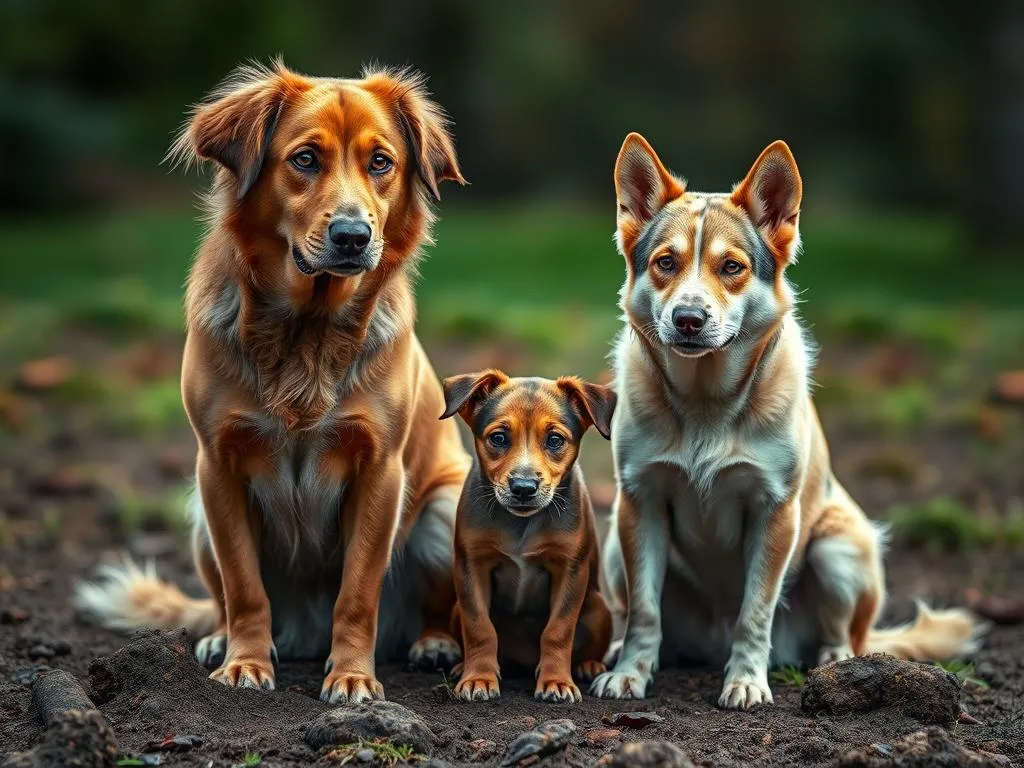
Introduction
Truffle hunting is an ancient practice that involves searching for these highly prized fungi, known for their distinct aroma and flavor, often used in gourmet cuisine. The significance of truffles extends beyond their culinary appeal; they have become a lucrative commodity, contributing to local economies and the gastronomic culture. Traditionally, truffle hunters relied on pigs, but the use of dogs in truffle hunting has gained popularity. Dogs, with their exceptional sense of smell and trainability, have proven to be highly effective in locating these underground treasures. Selecting the right dog breeds for truffle hunting is essential for a successful hunt. This article explores the nuances of truffles, the advantages of using dogs, key traits to look for in a truffle hunting dog, and a selection of the best breeds for this specialized task.
Understanding Truffles
What Are Truffles?
Truffles are a type of fungi that grow underground in symbiotic relationships with the roots of certain trees. There are several types of truffles, with the most notable being black truffles (Tuber melanosporum) and white truffles (Tuber magnatum). Black truffles are primarily found in France and Italy, while white truffles are most commonly associated with regions in Italy, particularly Piedmont. Their culinary and economic importance cannot be overstated; truffles are often referred to as “the diamonds of the kitchen,” fetching high prices in markets due to their rarity and unique flavor profiles.
The Process of Truffle Hunting
Truffle hunting can be approached in various ways, from traditional methods involving trained pigs to modern techniques utilizing dogs. The process generally involves searching in specific areas where truffles are known to grow, often near the roots of oak, hazelnut, and beech trees. The key to successful truffle hunting lies in the animal’s ability to detect the scent of truffles, which is released into the surrounding soil. Dogs are particularly adept at this due to their highly developed olfactory senses, making them ideal companions for truffle hunters.
Why Use Dogs for Truffle Hunting?
Advantages of Using Dogs
One of the primary advantages of using dogs for truffle hunting is their superior sense of smell. Dogs possess as many as 300 million scent receptors, compared to a human’s 5 million. This remarkable olfactory ability allows them to detect truffles buried deep underground. Additionally, dogs are highly trainable and can adapt to various environments, making them suitable companions for diverse hunting conditions. The bond formed between the dog and its handler also enhances teamwork, allowing for more efficient searches.
Comparison with Other Animals
While pigs have been traditionally used for truffle hunting due to their natural instinct to root around in the soil, they come with their own set of challenges. Pigs tend to eat the truffles once they find them, making them less reliable than dogs. Dogs, on the other hand, can be trained to alert their handlers without consuming the truffles. Both methods have their pros and cons, but the advantages of using dogs—such as their trainability and non-destructive nature—often make them the preferred choice among modern truffle hunters.
Key Traits of Ideal Truffle Hunting Dogs
Scent Detection Ability
The most critical trait for a successful truffle hunting dog is its olfactory sensitivity. Different breeds vary in their ability to detect scents, and certain breeds excel in this area. A dog’s ability to recognize and locate the specific scent of truffles can greatly influence the efficiency of a hunt.
Trainability and Temperament
Trainability is another essential factor when choosing a dog for truffle hunting. Breeds that are eager to please and possess a strong work ethic tend to excel in training. Additionally, a good temperament is vital; dogs need to be sociable and comfortable working in various environments while maintaining focus on the task at hand.
Stamina and Physical Attributes
Truffle hunting often requires long hours in the field, so stamina is an essential trait. Dogs should be physically fit and agile, able to navigate through different terrains without tiring easily. Size also plays a role; while larger dogs can be powerful, smaller breeds can be just as effective and may better navigate dense underbrush.
Top Dog Breeds for Truffle Hunting
Lagotto Romagnolo
Originating from Italy, the Lagotto Romagnolo is often referred to as the original truffle dog. This breed has a unique coat that helps protect them in wet and muddy terrains. Their keen sense of smell and natural instinct for hunting make them highly effective truffle hunters. Training a Lagotto Romagnolo can be a rewarding experience, as they are intelligent and eager to learn. Positive reinforcement techniques work particularly well with this breed.
German Shepherd
The German Shepherd is a versatile and intelligent breed, known for its strong work ethic and loyalty. These dogs are not only used in various service roles but also excel at truffle hunting. Their ability to learn complex commands and their robust physicality make them well-suited for long hunts. Training a German Shepherd for truffle hunting involves building a strong foundation of obedience, followed by specialized scent training to help them recognize truffles.
Springer Spaniel
The Springer Spaniel is known for its natural hunting instincts and playful demeanor. This breed is energetic and loves to work, making them excellent companions for truffle hunters. Their adaptability means they can thrive in various environments, from forests to fields. When training a Springer Spaniel, it’s crucial to incorporate plenty of play and exercise to keep them engaged and motivated.
Labrador Retriever
The Labrador Retriever is one of the most popular dog breeds worldwide, known for its sociability and eagerness to please. This breed has a strong sense of smell and is often used in scent detection roles, making them suitable for truffle hunting. Their friendly nature and willingness to work alongside their handlers make training enjoyable. Incorporating scent detection exercises into their routine can enhance their capabilities in the field.
Other Notable Breeds
Several other breeds also show promise for truffle hunting. Beagles, with their exceptional scent detection abilities, are known for their persistence. Belgian Malinois are agile and intelligent, making them suitable for various tasks, including truffle hunting. Each breed has its strengths and weaknesses, and it’s essential to consider the specific traits that align best with the demands of truffle hunting.
Training Your Dog for Truffle Hunting
Basic Obedience Training
Before diving into specialized truffle hunting training, establishing a strong foundation of basic obedience is crucial. Commands such as “sit,” “stay,” and “come” are fundamental for effective communication between the dog and handler. Consistency and positive reinforcement are key in this training phase.
Scent Training Techniques
Scent training is the heart of preparing a dog for truffle hunting. Start by introducing your dog to the scent of truffles, using truffle oil or small pieces of truffles if available. Gradually increase the difficulty by hiding the scent in various locations, allowing your dog to locate it through scent tracking. Common challenges in scent training include distraction and over-excitement, so it’s important to practice in controlled environments before heading into the field.
Building the Hunting Bond
The relationship between the dog and the handler is vital for successful truffle hunting. Trust and teamwork can be developed through various activities, such as agility training, fetch, or even casual walks in the woods. These shared experiences strengthen the bond and improve the dog’s focus during hunts.
Tips for Successful Truffle Hunting
Choosing the Right Location
The habitat is crucial for finding truffles. Ideal environments include areas with specific tree species, such as oaks and hazelnuts, where truffles are known to grow. Seasonal considerations also play a role; truffles typically grow in the fall and winter, so planning hunts accordingly can lead to better results.
Understanding Truffle Signs
While hunting, it’s essential to be observant of the signs that indicate truffles might be nearby. Dogs often exhibit specific behaviors, such as digging or sniffing intently at certain spots, which can signal the presence of truffles. Learning to read these cues can enhance the effectiveness of the hunt.
Ethical Hunting Practices
Responsible truffle hunting is vital for sustainability. Overharvesting can lead to depletion of truffle populations. It’s important to follow guidelines for ethical hunting, including only harvesting mature truffles and avoiding damage to the surrounding environment. Sustainable practices ensure that future generations can enjoy the rewards of truffle hunting.
Conclusion
Choosing the right dog breeds for truffle hunting is essential for success in this rewarding pursuit. The right breed, along with proper training and ethical practices, can lead to a fruitful and enjoyable experience in the field. By understanding the traits that make certain breeds suitable and implementing effective training techniques, truffle hunters can foster a strong partnership with their dogs, enhancing both the hunt and their bond. The journey of truffle hunting offers not only the thrill of discovery but also the joy of working alongside a beloved companion in nature’s bounty.









